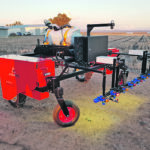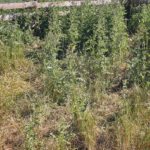Intercropping, predictive weed control could redraw the battle lines in the fight against herbicide resistant weeds
Herbicide resistance in weeds is rising and there are no new chemistries on the horizon, so farmers will need fresh approaches to integrated weed management strategies. “I think the best management practice that someone could do for weed resistance is the one you’re not currently doing on your farm,” said Rory Cranston, technical strategy lead […] Read moreTag Archives weed management

Inter-row spraying, weed wicking wild oats

Do it yourself green on brown spotting
Open source weed detection for sprayers or precision tillage is based on camera sensors identifying the targets
The design for a green on brown weed locator is now available to anyone who wants to build their own site-specific weed management tool. The OpenWeedLocator (OWL) is an open-source, low-cost image-based approach for fallow weed detection. Guy Coleman from the University of Sydney, Australia, is working on the project. He said the OWL is […] Read more
App makes instant weed ID possible

Herb resistant crops remain best way to control weeds

Farmers must foster weed seed eaters
Crickets and ground beetles are effective predators, often found in shelterbelts and outer strips of the field
If farmers hear crickets out in their fields they should consider themselves fortunate because that’s the sound of free weed-seed control. “If you hear the crickets, that means the carabids are out. All of the sounds you hear in the evenings, that’s weed-seed predation,” said Chris Willenborg during his presentation at the Saskatchewan Pulse Growers […] Read more
Hot air, lasers, irradiation scrapped; researchers decide on electrocution

Camera controls cultivator between rows
Row-Guard cultivates between rows on 5.9 inch centres without a twisted neck, headache, back pain or crop damage
Inter-row cultivation is no longer the exclusive domain of row croppers and organic farmers. The practice has also become a new option for producers with herbicide resistance in broad acre crops such as wheat and canola. Machinery operators who have struggled to manually keep their cultivator between rows and out of trouble are probably not […] Read more
Study examines harvested weed seed control
Volunteer canola was the best candidate because it retains its seeds high in the canopy, unlike wild oats which constantly shed
Harvested weed seed control is a strategy to prevent viable weed seeds from returning to the field at harvest. It has proven useful in Australia in the fight against herbicide resistant weeds such as rigid ryegrass. Breanne Tidemann, a Ph.D. student at the University of Alberta, is studying which prairie weeds are vulnerable to the […] Read more
VIDEO: Layers of herbicides help avoid resistance
Layering may be used to reduce multiple resistance in one weed or address several weeds that are prone to resistance
REGINA — Prairie grain producers have been relatively lucky when it comes to herbicide resistant weeds, especially when comparing their experience to some European and American farmers. However, producers should quickly adopt strategies that reduce the probability of resistance developing in weeds if they want to avoid the staggering costs associated with herbicide resistance, said […] Read more





